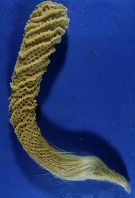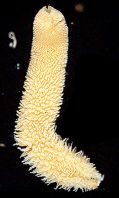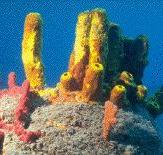
(hexactinellid sponge) |
PHYLUM PORIFERA
(= sponges) (tree & traits from
|

(calcareous sponge) |

(demosponge) |

(hexactinellid sponge) |
PHYLUM PORIFERA
(= sponges) (tree & traits from
|

(calcareous sponge) |

(demosponge) |
====== Calcarea (includes ascon, sycon & leucon grades)
==2==|
| ====== Homoscleromorpha (coralline sponges; leucon grade)
<<===1==|
| ==4=== Hexactinellida (glass sponges; no regular canal system)
==3==|
==5=== Demospongia (most living sponge species; leucon grade)
Back to Zool 250 tree for animal phyla
TRAITS SUPPORTING EACH CLADE (** plesiomorphic- a primitive state, not unique to clade):
|
b) water canal system with pumping choanocytes** (monociliated cells with diplosome) c) extensive mesenchyme (gelatinous proteinaceous matrix containing skeletal material and amoeboid cells) d) silica spicules, initiated intracellulary e) pinacoderm (epithelium-like outer layer) lacking basal lamina and intercellular junctions in some groups f) dynamic tissue remodelling (reversible differentiation of most cell types) b) porocytes (pore cells) |
b) most cells, including collar cells, are part of an extensive syncytium (multinucleate fabric of cells) b) distinctive 4-pointed spicule (tetraxon) c) porocytes (pore cells) |
PARAPHYLETIC PORIFERA? (alternative molecular phylogeny from Sperling et al. 2009) (OPTIONAL, for information only)
=========== Hexactinellida (glass sponges; no regular canal system)
=====|
| =========== Demospongia (most living sponge species; leucon grade)
<<======|
| ============= Calcarea (includes ascon, sycon & leucon grades)
===|
| ========== Homoscleromorpha (coralline sponges; leucon grade)
===|
| ======== Placozoa (placozoans, Trichoplax)
==|
======== EUMETAZOA